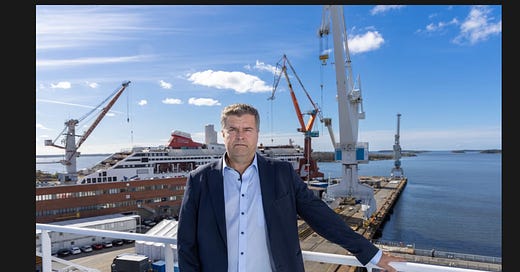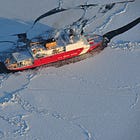Finnish and Canadian Firms Team Up to Offer Arctic Security Cutters to U.S. Coast Guard
According to the proposal, Seaspan's Multi-Purpose Icebreaker design would be built in Finland by Rauma Marine Constructions (RMC), with Aker Arctic (who did the concept design) providing support.
I’m currently away from Finland, visiting family in the USA. Last week, while I was grilling hamburgers and hot dogs during a family Independence Day Barbecue, a regional Finnish newspaper (Satakunnan Kansa) ran a very interesting article:
RMC’s Nieminen returned from a sales trip to the USA: “Rauma Shipyard is Number One.”
RMC is part of a consortium that is offering two icebreakers to the U.S. Coast Guard, as well as extensive training.

(translation via google, with some corrections for clarification):
A satisfied man walked through Helsinki-Vantaa Airport on Thursday afternoon. RMC CEO Mika Nieminen returned from a sales trip to the USA, where he brought back some good news.
Nieminen was presenting the ship design of the consortium he represents to the US Coast Guard and the reception was excellent.
“Our ship design exceeded expectations and it is the design that the Coast Guard wants. The number one is the Rauma shipyard, which would also build it. The feedback was very positive.”
In addition to RMC, the consortium represented by Nieminen includes the Canadian shipbuilder Seaspan Shipyards and the Finnish ship design firm Aker Arctic Technology Oy.
The Canadian shipyard will start building medium-sized icebreakers based on the same model next year. Canada plans to build 16 icebreakers. This same ship model is now being offered to the US Coast Guard, but with RMC building the ships.
This is clearly referring to Seaspan’s Multi-Purpose Icebreaker (MPI) design, which I discussed in a recent article:
Canada’s Multi-Purpose Icebreaker (MPI, formerly known as the Multi-Purpose Vessel): Modern design that meets all of the listed requirements [for the U.S. Coast Guard’s Arctic Security Cutters]. The first flight of six vessels (of a planned sixteen) are scheduled to be built by Seaspan at their Vancouver shipyard….
Seaspan’s Vancouver Shipyard is at capacity through approximately 2029. While they will begin building MPIs for the Canadian Coast Guard, there is no room to build one for the U.S. Coast Guard in the relevant timeframe….
Building MPIs at RMC is an interesting idea, but I have no idea if that is actually under consideration.
It is more than just under consideration. According to the Satakunnan Kansa article, RMC would build the first two MPIs for the U.S. Coast Guard in Finland by 2028. The deal would also involve working with U.S. shipbuilders to ensure they had the training and skill to build subsequent vessels of the class in the USA. Cost information is not yet available.
Note: The MPI image does not show the right propulsors; it will use Steerprop’s contra-rotating propulsors (CRP). Additionally according to Seaspan, the design could easily be upgraded to PC3.
Confirmation from Seaspan and Aker Arctic
In April, Finnish newspaper Helsingin Sanomat published an article about negotiations between the U.S. Coast Guard and RMC to build a significant number of icebreakers, but the details were not subsequently confirmed. Before publishing this article, I reached out to RMC, Seaspan, and Aker Arctic for comments. As of press time, Aker Arctic and Seaspan responded, confirming many of the details in the article.
Arto Uuskallio, Head of Sales at Aker Arctic, commented via e-mail:
It's natural that we are involved, since the MPI is an Aker Arctic concept, and it's good to have a partner onboard who understands the possibilities and limitations of the ship concept. More detailed comments will likely come from the shipyards.
Dave Hargreaves, Seaspan’s Senior Vice President for Strategy, Business Development, and Communication, provided the following comments via e-mail:
We have consulted with many U.S. and non-U.S. shipyards regarding their readiness and aptitude to build the MPI design for the U.S. Coast Guard ASC program including Rauma Shipyard in Finland.
Rauma has a track record of delivering ice-capable vessels in less than 36 months — including recent programs. As a fully capable, end-to-end shipyard, Rauma is the lowest risk and best option to meet the 36-month requirement. Unlike other shipyards, Rauma has an active panel line and block fabrication facility that is ready to start production today — it does not require any further investment or ramp up in workforce to begin construction. This significantly lowers the risk of meeting the schedule requirement.
Together, with Rauma and Aker, Seaspan has developed a comprehensive plan detailing how we will work with a U.S. shipyard to transfer the design, knowledge, expertise and build plans to enable future ASC vessels to be built in the United States. This approach will deliver a comprehensive, U.S.-built ASC fleet for the U.S. Coast Guard while enhancing domestic icebreaker shipbuilding — avoiding the delays, costs and risks of long-term, high-investment alternatives.
I take his comment about schedule risk as a subtle dig at Davie/Helsinki Shipyard. I’ve been reading these press releases and comments long enough to see the back-and-forth, sometimes subtle, between Seaspan and Davie, and RMC and Helsinki Shipyard. I expect to read more of this, but am much more interested in tracking the progress of ongoing ship construction (such as the Canadian Polar Icebreakers being built by Seaspan and Davie) than in following their rhetorical barbs.
Helsinki Shipyard has an excellent track record of delivering icebreakers in less than thirty-six months, as I noted here.
Rauma Marine Constructions was unable to provide additional comments by publication time, but did say that more information would be coming out soon.
Thoughts and Comments
The Multi-Purpose Icebreaker is a solid design, and Rauma Marine Constructions is a capable shipyard with a solid track record. As my goal in writing about icebreakers has always been to assist the U.S. Coast Guard in getting the ships that it needs in a relevant timeline, I view the Seaspan/RMC/Aker consortium’s proposal as a positive development.
Davie does not comment on any of its ongoing negotiations, but it seems likely that it is offering its MPPS-100 to the U.S. Coast Guard to be built first in Helsinki Shipyard, and later (perhaps) in Texas.
The only announced player without any information about its proposed design is the United Shipbuilding Alliance created by Bollinger and Edison Chouest Offshore.
May the U.S. Coast Guard get the best ships for its needs in the shortest amount of time and at a good price! I’ll certainly be tracking all of these details closely.
Thanks for reading. Be sure to subscribe and share so that you never miss an update on this fast-moving and important topic.
Until next time-
All the Best,
PGR
Further reading/references:
Analyzing the Arctic Security Cutter Request for Information
Note: The responses to the RFI will most likely remain private, and th…
Also contains RMCs capabilities:
How to Build an Icebreaker in Three Years
Building icebreakers. It shouldn’t be that hard. European shipyards, especially those located in Finland, routinely design and build these specialized ships for a variety of purposes. In North America, however, it’s a different story. Both the U.S. and Canada have struggled over the past decade with delays in designing and building their own polar i…









One of these new Finish Arctic Security Cutters would make a great GLAKES HEAVY Icebreaker. I think they will fit through the locks. Should that be the case . . . and the U.S. Navy decide to stand up a MISSILE RANGE in Lake Superior for FFG-62 CSSQT'a one of these would make a great command ship to monitor the exercise and provide range safety. Regardless, the USCG should designate a 3D radar for all cutters doing service in the poles regardless of mission. The AN/SPS-75 radar on the National Security Cutter is good, and so is the AN/SPS-77 which is a multi-role medium-range 3D surveillance radar system that will be on the OPC.
The Seaspan design is not the only game in town. Vard 9-201 features everything in the Seaspan design and Vard 9-203 is limited in aids to navigation capability but excels in the rest and can be build with different propulsion options.